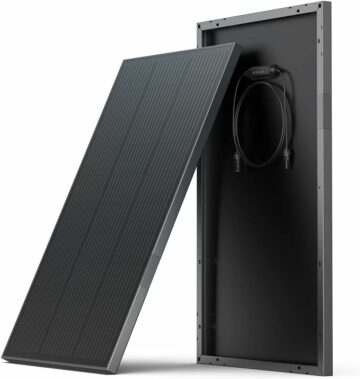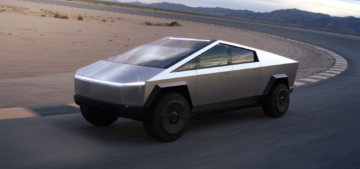
Sign up for daily news updates from CleanTechnica on email. Or follow us on Google News!
We get a lot of great comments here on CleanTechnica. From time to time I think, “that’s a great full article!” I’m planning to start publishing these when I spot them. To kick this off, below was most of a comment from a reader in a comment thread about Tesla FSD in January. Enjoy! Or, if you don’t, feel free to carry on the conversation down in the comments!
Alternatively, if you’d like to directly contribute an op-ed for consideration, go to CleanTechnica.com/contact
By Charlie Doyle
1. I’m just pushing back because FSD has been mostly bullshit for a decade now, and they still can’t average ten safe driverless miles in a busy city (Waymo is at 9 million real robotaxi miles and counting). Yet you silly fanboys believe Elon’s stories, like children. My message to you is, pay more attention to the real AV sector, and the huge challenge of getting an urban robotaxi license. Waymo is so far ahead that it’s silly to think FSD is even in the game, especially for their near-term-unattainable goal of a Level-5 driver and robotaxi.
2. Neural nets (NNs) and large language models (LLMs) are used by every AI company now, including Waymo. New LLM companies are popping up like weeds. It’s not like Tesla has any advantage there. Waymo’s AI is of course deep neural networks; their Driver is replete with NNs. As for LLMs, like I said, Google engineers invented the current algorithm for LLMs, called transformers. And they have Bard, the only good rival to ChatGPT. So what? LLMs have nothing to do with driving. That’s all language, text AI. The algorithms for good computer-vision AI will be totally different than LLMs.
3. Geo-fencing with maps is likely necessary for a licensed, safe AV. FSD still isn’t close to solving tricky intersection layouts, roundabouts, weird nonstandard infrastructure, etc., which could be quickly solved with HD maps. And your Tesla-fanboy obsession with “geo-fencing can’t scale” is silly. Mobileye has mapped all of the U.S. and Europe already with their REM crowd-source mapping tech, using their ADAS systems on millions of consumer cars. It’s proven that mapping can be done cheaply, quickly, at scale. There are several mapping companies that can do what Mobileye is doing. Waymo can themselves map a large test area in a few months. If they wanted to, they could partner with mapping companies to map the whole country fast enough. The bottleneck for scaling a robotaxi business is getting licenses from the regulators in each area, which Tesla has no plan for. No state is gonna hand them a driverless license based on Elon’s words. Tesla will have to get licenses exactly like Waymo and the others, one small test-neighborhood at a time, until they prove over millions of driverless miles in each area that FSD is really safe.
5. Waymo is learning to drive in all categories first (city streets, highways, suburban/rural, parking lots, rain/fog, pickups/dropoffs). When they accomplish all of that with an ultra-safe, licensed driver, which appears to be in 2024 if you consider their recent announcements and CA DMV license in L.A. and the Bay Area for a huge driverless expansion (Google it if you haven’t heard), they will move to the next expansion phase.
The only hardware that needs shrinking is the roof-top LIDAR, which will surely get cheap and much smaller as production ramps up. LIDAR on a chip, including 360-degree LIDAR, is coming very soon from MIT and others. All of Waymo’s sensors will be cheap and elegant soon enough. What you’re seeing now is an early test fleet, like an early Wright Brothers plane.
Chirping about big ugly LIDAR on the roof shows you don’t understand tech. As soon as the market demand grows, the electronics will get cheap and the packages will shrink and disappear into the car panels. A real robotaxi needs prominent markers on it too (as do most regular taxis), to communicate with emergency crews and flash customers, and for security to only allow the paying customer to enter and deter bad guys. Waymo will likely be selling their entire Driver to OEMs for a few thousands dollars when the demand gets big, as will Mobileye and several Chinese companies, and probably Zoox, Apple, Motional, Aurora, and Cruise.
As for China, Tesla won’t be selling driverless cars in China either. Their driver doesn’t work. The Chinese companies like Baidu and others have that covered. Elon can’t bluff the CCP with magic stage shows.
Waymo partnering with an OEM for their cars is a good thing. They will be using the Geely Zeekr robotaxi, a cheap custom-built robotaxi from the ground up that looks quite elegant. Sounds like a great plan to me. Waymo doesn’t have to build their own giant new auto factory and they’ll have the most elegant robotaxi in the world, with the best ADS in the world. Waymo will just be the ADS company and robotaxi-business operator, which are likely both huge markets.
A generally-capable Optimus is much harder than Level-5 driving, so if they can’t get a city Level-4 driverless license, Oppy won’t be doing much if it involves safety-critical manufacturing. Perhaps they’ll find a few simple dummy tasks it can do, but I’m skeptical it will be good enough to merit scaling it up for a huge market as a general labor replacement. Common sense in a robot is a completely unsolved problem. But, I do like the Optimus program. The over-hype is annoying, but I always love to see bold attempts at difficult tech. Oppy will be much like FSD: constant hype and over-promises, and yearly goalpost moving by Elon as far as the eye can see. But at least Elon has inspired lots more robot programs. I love that. Same with the solar roof tiles: weird over-promising and goalpost moving, but at least a real company is working on it and inspiring other companies to jump in.
Featured image courtesy of Waymo
Have a tip for CleanTechnica? Want to advertise? Want to suggest a guest for our CleanTech Talk podcast? Contact us here.
Latest CleanTechnica TV Video
[embedded content]
Advertisement
CleanTechnica uses affiliate links. See our policy here.
- SEO Powered Content & PR Distribution. Get Amplified Today.
- PlatoData.Network Vertical Generative Ai. Empower Yourself. Access Here.
- PlatoAiStream. Web3 Intelligence. Knowledge Amplified. Access Here.
- PlatoESG. Carbon, CleanTech, Energy, Environment, Solar, Waste Management. Access Here.
- PlatoHealth. Biotech and Clinical Trials Intelligence. Access Here.
- Source: https://cleantechnica.com/2024/02/29/tesla-is-way-behind-waymo-reader-comment/
- :has
- :is
- :not
- $UP
- 2024
- 360-degree
- 9
- a
- About
- accomplish
- ADAs
- Ads
- ADvantage
- Advertise
- Affiliate
- ahead
- AI
- algorithm
- algorithms
- All
- allow
- already
- always
- an
- and
- Announcements
- any
- appears
- Apple
- ARE
- AREA
- AS
- At
- Attempts
- attention
- Aurora
- auto
- AV
- average
- back
- Bad
- Baidu
- based
- Bay
- BE
- because
- been
- behind
- believe
- below
- BEST
- Big
- bold
- both
- bottleneck
- brothers
- build
- business
- busy
- but
- by
- CA
- called
- CAN
- car
- carry
- Carry On
- cars
- categories
- ccp
- challenge
- Charlie
- ChatGPT
- cheap
- cheaply
- Children
- China
- chinese
- chip
- City
- cleantech
- Cleantech Talk
- Close
- coming
- comment
- comments
- Common
- common sense
- communicate
- Companies
- company
- completely
- Consider
- consideration
- constant
- consumer
- content
- contribute
- Conversation
- could
- counting
- country
- course
- courtesy
- covered
- cruise
- Current
- Custom-built
- customer
- Customers
- decade
- deep
- deep neural networks
- Demand
- different
- difficult
- directly
- disappear
- do
- Doesn’t
- doing
- dollars
- done
- Dont
- down
- drive
- driver
- Driverless
- driverless cars
- driving
- dummy
- each
- Early
- either
- Electronics
- Elon
- embedded
- emergency
- Engineers
- enough
- Enter
- Entire
- especially
- etc
- Europe
- Even
- Every
- exactly
- expansion
- eye
- factory
- far
- FAST
- feel
- few
- Find
- First
- Flash
- FLEET
- For
- Free
- from
- FSD
- full
- game
- General
- get
- gets
- getting
- giant
- goal
- good
- great
- Ground
- Grows
- Guest
- hand
- harder
- Hardware
- Have
- heard
- here
- highways
- http
- HTTPS
- huge
- Hype
- i
- if
- image
- in
- Including
- Infrastructure
- inspired
- inspiring
- intersection
- into
- Invented
- involves
- IT
- January
- jump
- just
- kick
- labor
- language
- large
- learning
- least
- License
- Licensed
- licenses
- lidar
- like
- likely
- links
- llm
- LOOKS
- Lot
- lots
- love
- magic
- manufacturing
- map
- mapping
- Maps
- Market
- Markets
- me
- Merit
- message
- million
- millions
- MIT
- Mobileye
- models
- months
- more
- most
- mostly
- move
- moving
- much
- my
- necessary
- needs
- Nets
- networks
- Neural
- neural networks
- New
- news
- next
- no
- nothing
- now
- of
- off
- on
- ONE
- only
- Op-ed
- operator
- or
- Other
- Others
- our
- over
- own
- packages
- panels
- parking
- partner
- partnering
- Pay
- paying
- perhaps
- phase
- plan
- plane
- planning
- plato
- Plato Data Intelligence
- PlatoData
- player
- podcast
- policy
- popping
- probably
- Problem
- Production
- Program
- Programs
- prominent
- Prove
- proven
- Publishing
- Pushing
- quickly
- quite
- Ramps
- Reader
- real
- really
- recent
- regular
- Regulators
- replacement
- replete
- Rival
- robot
- robotaxi
- roof
- s
- safe
- Said
- same
- Scale
- scaling
- sector
- security
- see
- seeing
- Selling
- sense
- sensors
- several
- Shows
- Simple
- skeptical
- small
- smaller
- So
- so Far
- solar
- Solving
- Soon
- sounds
- Spot
- Stage
- start
- State
- Still
- Stories
- streets
- suggest
- surely
- Systems
- Talk
- tasks
- tech
- ten
- Tesla
- test
- text
- than
- that
- The
- the world
- their
- Them
- themselves
- There.
- These
- they
- thing
- Think
- this
- thousands
- time
- tip
- to
- too
- TOTALLY
- transformers
- tricky
- tv
- u.s.
- understand
- until
- Updates
- urban
- us
- used
- uses
- using
- very
- Video
- want
- wanted
- was
- Way..
- waymo
- weird
- What
- when
- which
- whole
- will
- with
- words
- Work
- working
- world
- Wright
- yearly
- yet
- you
- Your
- youtube
- zephyrnet





